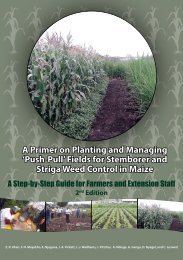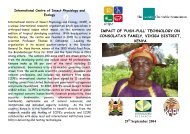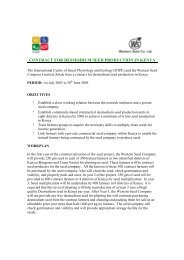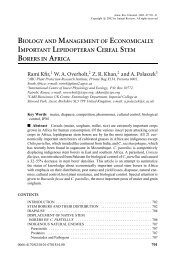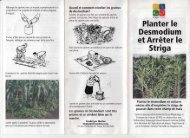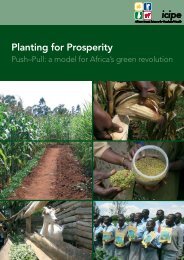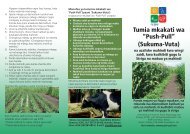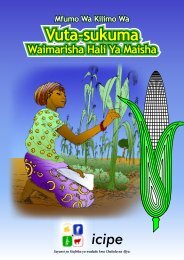The Royal Society Report - Push-Pull
The Royal Society Report - Push-Pull
The Royal Society Report - Push-Pull
Create successful ePaper yourself
Turn your PDF publications into a flip-book with our unique Google optimized e-Paper software.
Genes or combinations of genes affecting crop production<br />
can be easily identified using genomics. In genetic<br />
improvement strategies these genes can be targeted in<br />
breeding programmes or they can be transferred into crops<br />
by GM as described in more detail below. However, it should<br />
be stressed that the information from genomic studies is<br />
also important for the science that underpins changes in<br />
crop management. <strong>The</strong> information about genes, proteins<br />
and metabolites in crop plants allows strategies for crop<br />
management to be developed that maximise agronomic<br />
performance of crops in a sustainable way.<br />
New methodologies for determining DNA sequences are<br />
orders of magnitude more efficient than the methods used<br />
for the first generation of genome sequences from model<br />
organisms and man. <strong>The</strong>re are several versions of these<br />
new methods and it is likely that others will emerge in the<br />
near future. Sequencing a genome is currently being<br />
transformed from a multimillion pound project into one<br />
costing less than one million pounds for a completely new<br />
genome and a few thousand pounds for an individual of a<br />
species for which a full genome is already available.<br />
Generating the DNA sequence data is now straightforward<br />
and cheap: the computational analysis and annotation of<br />
the sequence is the most expensive and time-consuming<br />
part of a genome project.<br />
Genome sequencing methods were first applied to the<br />
model plant species Arabidopsis and we now have<br />
complete genome sequence data of Arabidopsis thaliana,<br />
rice, maize, sorghum, soya bean, poplar, grapevine and<br />
papaya. With the introduction of the new sequencing<br />
technology it is likely that ongoing genome projects for<br />
wheat, potato, tomato, sunflower, apple, pear, peach,<br />
strawberry and other crops can be accelerated. 5 Other<br />
crop genome sequences could be completed in relatively<br />
short times and it will be possible to generate data from<br />
several varieties of previously sequenced crops.<br />
3.2.1.2 Marker technology<br />
Plant breeding is a well established method for improving<br />
the performance of crop plants by making defined crosses<br />
between genetically distinct parents, screening progeny<br />
for desired trait combinations and selecting preferred<br />
individuals with better combinations of characteristics that<br />
can then be bulked and developed into lines and varieties.<br />
<strong>The</strong> procedures for screening progeny for desired traits are<br />
often the most challenging stages in conventional plant<br />
breeding because many plant lines have to be tested for<br />
phenotypes that may be difficult to assay. Disease resistance,<br />
for example, can normally be identified only after extensive<br />
testing of multiple plants in each line for susceptibility.<br />
Similarly, yield enhancements cannot be identified by<br />
collecting the products from a single plant; the products<br />
from several plants need to be combined and measured<br />
accurately in replicated tests. <strong>The</strong> advances described below<br />
allow these screening procedures to be streamlined.<br />
5 See http://www.Phytozome.net.<br />
Breeders and geneticists can often show that defined traits<br />
are conferred by specific genes, or are associated with<br />
quantitative trait loci (QTL)—stretches of DNA strongly<br />
associated with the gene for a particular trait. <strong>The</strong>se traits<br />
are often difficult to measure, requiring laborious and<br />
incompletely reliable assessment methods. It therefore<br />
makes breeding easier if instead of measuring the trait, a<br />
molecular DNA genetic marker linked to the QTL can be<br />
monitored in progeny. This method is cheaper and more<br />
reliable. In addition, undesirable traits are often genetically<br />
linked to desired traits. This is known as linkage drag. DNA<br />
markers help identify rare plants in a breeding program in<br />
which the desired trait is retained but deleterious traits are<br />
left behind. This is referred to as marker-assisted selection<br />
(MAS). DNA marker technology has evolved through<br />
several stages. In its most advanced form, it is based on a<br />
genome sequence and generates dense genetic maps in<br />
which the markers are very close to, or may actually<br />
represent, the gene of interest. More complex applications<br />
of MAS involve selection for traits affected by multiple<br />
genetic loci.<br />
An example of the application of MAS is in the development<br />
of submergence-tolerant rice. In rice, the major genetic<br />
determinants of flooding tolerance have been identified and,<br />
using this information, MAS has been employed to develop<br />
flooding tolerant varieties (Hattori et al. 2009; Singh et al.<br />
2009; Voesenek & Bailey-Serres 2009). Many other<br />
examples of MAS suggest that this approach will be<br />
increasingly important in breeding as genome sequence<br />
data become available for more crop plants.<br />
3.2.1.3 Genetic modification<br />
Traditional and marker-assisted plant breeding involve the<br />
introduction of novel traits into crops by crossing as<br />
described above. <strong>The</strong> crosses might involve different<br />
genotypes of the crop or they might involve the crop and a<br />
related species (interspecific crosses). Progeny of the<br />
crosses are selected for traits of interest using DNA<br />
markers. Traditional plant breeding is slow, taking 10 years<br />
or more for a breeding cycle. Furthermore, breeding of<br />
some crops which are not propagated by seed, such as<br />
potato and banana, is extremely difficult. In molecular GM,<br />
novel genes are introduced, either individually or in small<br />
groups, into a crop plant. <strong>The</strong> genes inserted may either be<br />
from the same species (this is known as cisgenics) or from<br />
another species (transgenics). <strong>The</strong>se methods circumvent<br />
the crossing cycle associated with conventional genetic<br />
improvement and in cisgenic approaches they allow<br />
transfer of genes within a species but without the<br />
complication of linkage drag.<br />
GM-based methods are used widely as a routine tool in<br />
research and they have greatly facilitated major advances<br />
in plant biology over the last 25 years. <strong>The</strong>y are particularly<br />
important in the ongoing task of assigning function to each<br />
of the 10,000 to 20,000 genes which have been identified<br />
in each species and in elucidating the cellular mechanisms<br />
in plant biology. <strong>The</strong> application of GM techniques in crop<br />
plants, however, has been controversial. In the USA,<br />
22 I October 2009 I Reaping the Benefits <strong>The</strong> <strong>Royal</strong> <strong>Society</strong>



